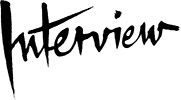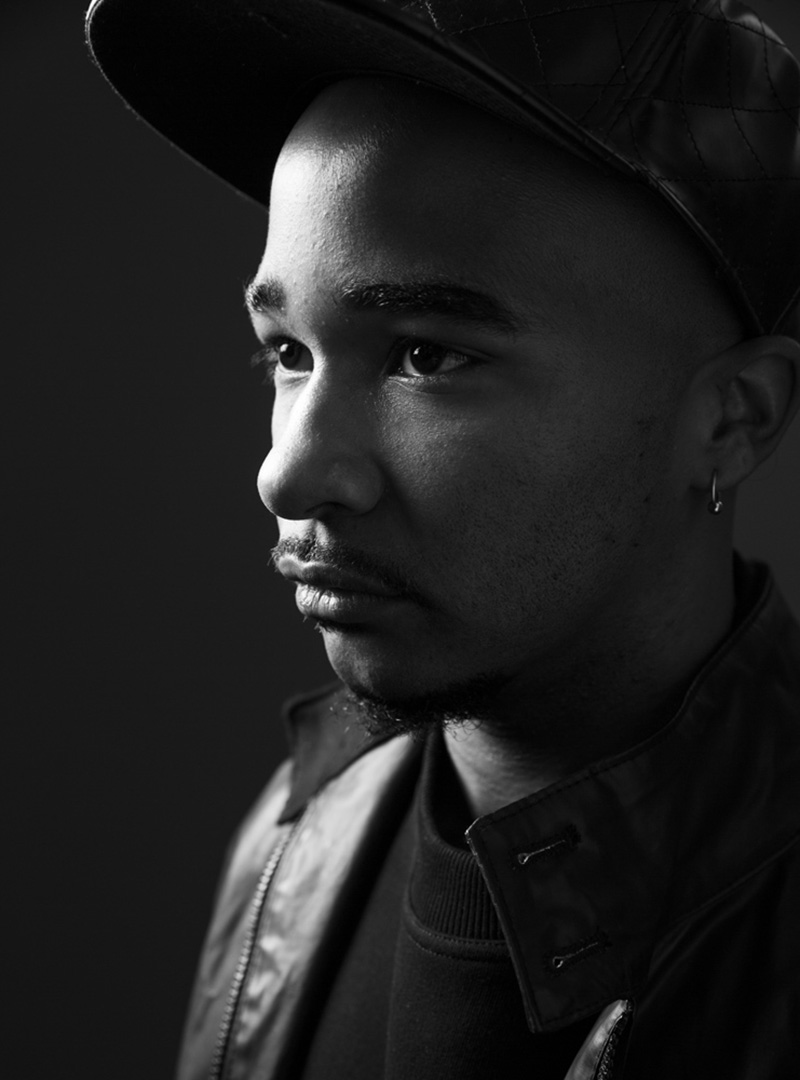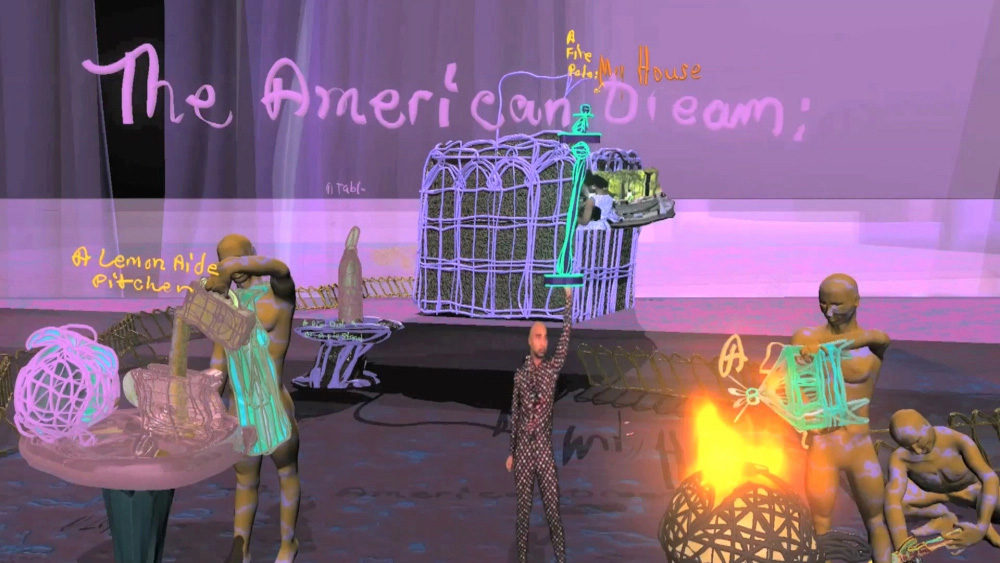
- Source: Interview Magazine
- Author: Rachel Small
- Date: December 19, 2014
- Format: PRINT AND DIGITAL
THE DIGITAL CREATOR
Jacolby Satterwhite
Watching Jacolby Satterwhite’s fast-paced 3-D digital animations, viewers should be prepared to relinquish their grasp on reality. Disjointed narratives take place in nebulous, neon-hued terrain; bodies and objects appear and disappear as strange masses and written words spin in space; erratic sprays of globule-like orbs snake around and spring from characters, often representing bodily fluids. It’s pure fantasy, not unlike Surrealist dreamscapes.
But Satterwhite, 28, creates his animations by collaging elements from the real world, rendered with a program called Maya. To construct digital environments, he appropriates objects that are both mundane and intimate, highbrow and lowbrow. He might distort Internet stock images, or photos captured on the street. Once, he re-contextualized the composition of Caravaggio’s The Incredulity of Saint Thomas (1601-2) to set the stage for a queer immaculate conception. In earlier works, many components come from his mentally ill mother’s drawings, which, the artist explains, started as sketches alongside written descriptions that she would submit as inventions to companies behind paid programming.

Photograph by Frank Sun.
Satterwhite also uses his own body, filming himself and then creating a lookalike avatar–or crowds of them–from the footage. He usually performs his own choreography that pulls from hip-hop and vogueing, a hobby he picked up from his older brothers, who, like him, are gay. Sometimes he’ll perform on the streets of New York, filming his surroundings with a camera on his head, and thus, outsiders will make appearances in his world, too. He is also collaborating with the rapper Trina, and one work centers on a real-life sex encounter, reproduced in animation, that he prearranged with the porn star Antonio Biaggi.
Following a string of successful exhibitions in 2012 and 2013, Satterwhite broke out when Reifying Desire 1-6 (2011-14) was displayed at the 2014 Whitney Biennial this past spring. In November, he had his first solo show at OHWOW Gallery in Los Angeles, which included large-scale prints that doubled as storyboards–a first for the artist. In 2015, he will be in group shows at ICA Boston, Seattle Art Museum, and Yerba Buena Center for the Arts in San Francisco; additionally En Plein Air: Diamond Princess, the realization of the storyboards at OHWOW, will premiere at the Perez Art Museum Miami.
Years before digital animation was plausibly an accessible medium, Satterwhite was an avid video gamer growing up in South Carolina. He studied painting in high school, college, and grad school at The University of Pennsylvania, receiving his MFA in 2010. Towards the end of his studies, he began dabbling in performance art, which became more involved as he started digitally manipulating video documentation of performances. He eventually shifted his focus to animation, translating components of his live action films into a total virtual reality.
We spoke to Satterwhite over the course of two meetings at the Interview offices. The first time, we agreed to adjourn so Satterwhite could return with his computer. The second time, he talked us through videos scene by scene.
JACOLBY SATTERWHITE: I was a gamer and hacker and was into a lot of things that have built me to where I am now. At five years old, I was teaching myself how to draw to help my mom make drawings. I eventually started to work on my own vocabulary and style, because I realized the drawings weren’t being made for what I thought I was making them for. I started making these stylized narrative paintings in my bedroom while playing video games and watching Madonna concerts and Björk music videos. I was binging on experimental film, the Internet, SHOWstudio, and Nick Knight. So basically my lexicon was being constructed through a prism of fashion, art, dance, music, and gaming. My brothers were both very influential because they were dancers and designers. They’re much older than me.
RACHEL SMALL: But you started off studying painting–how did you grow away from that?
SATTERWHITE: I had roadblock with painting because of the Western tradition. Painting is so influenced by history, race, and post-structuralism. I just didn’t want to have anything to do with that. So I thought, “How can I avoid that narrative and have control over my message in my art?” That automatically brought me to doing performance art. One Christmas, I brought my mothers’ drawings back home from South Carolina. I studied a lot of Fluxus art, Dada, and surrealist histories, so I decided to try to use them in a way that I was familiar with and started using drawings in performance. So, my performances derived from the poetic language in her drawings.
Then, I made a lot of video art pieces in generic landscapes, like Central Park. I applied to Skowhegan [School of Painting and Sculpture] with that portfolio, then got in. I became really consumed by making video art–I wanted to touch my performances [in videos] in the way that I touched the canvas. Then I thought I really want to spend time with this video, so I started teaching myself animation. Through a lot of trial and error and failure, I figured I could actually trace the line work of my mother’s drawings, extract them and construct these massive performance arenas that were pictorial, color- and texture-based, and spatially dynamic. It also invited a solicited performance via green screen. In a way I got to quote gaming, like Final Fantasy for instance, how they have the aerial views. I could quote Caravaggio, Peter Paul Rubens, and Piero della Francesca, and I could also quote my naïve childhood, like being in the toy box with Esmeralda versus G.I Joe. I think that that was the moment of awakening.
My work is about observation in general. I’m interested in the potential of what observation can do when synthesized unnaturally. How can you bring together personal, private, and public? How can you bring together drawing, performance, animation, painting, and sculpture and weave them into a uniform space and make sense out of it? That’s why I called the series [in the Whitney Biennial] Reifying Desire. I was interested in how one person could concretize abstraction, because reification is about concretizing abstraction. It’s about making something unnatural and indefinable concrete. The whole oxymoron is that I never achieve specificity in my work, ever. It never concretizes; it just gets more abstract.
[Satterwhite insists that he return with his computer. We reconvene one week later.]

Image courtesy of the artist and Morán Morán, Los Angeles
SATTERWHITE: This is an archive that consolidates the main ideas in my practice, and it’s also a [standalone] piece, called The Matriach’s Rhapsody [2013]. What you’re looking at is my mother’s drawings, next to three-dimensionally rendered architectural versions of my mother’s drawings, family photographs, and other archived photographs from Google. I use this disparate pairing to come up with ideas for narratives and thematic tropes. [My mother was sending these drawings] originally to the Home Shopping Network or paid programs that were soliciting people to be entrepreneurs, [claiming that their] products could make millions. I guess my mom wanted the instructions to be clear. As her mental illness began to progress, she started to become a poet, kind of, and the language started to morph into more strange, surrealist, double entendre language games.
SMALL: It seemed like she had this impulse to invent.
SATTERWHITE: An impulse to invent, but also to document and archive the objects that entered her home and objects that could enhance her home or enhance the people around her–like if someone was sick, or if the dog needed a doghouse. They were almost like instructions to improve the space around her. I found that her strange chronic need to document [made for] an interesting archive for me to use to generate painting landscapes for me to perform in.
SMALL: Going back to recent times, your first solo show with OHWOW in Los Angeles wraps up this month. The show included large-scale prints, which you’ve said are storyboards for a new project, but they are also a new way for you to show your work. What did that mark in your evolution as an artist?
SATTERWHITE: What I like about the prints on aluminum is that they’re six feet tall and there’s a Hieronymous Bosch-like display of detail. There’s a careful amount of detail in each fragment of the print, which shows that the narrative is very complicated. I think it displayed my range of interest as an interdisciplinary artist… performance has had such a heavy umbrella over my practice over the years.
SMALL: I feel like it’s surprising that performance would overtake everything else in your practice.
SATTERWHITE: The thing is, performance is heavily part of it, because I take a lot of risks. Whether it was like having sex with a bareback porn star or wrestling people or casting Trina. I’m always testing out the potential to mediate the body between these technologies but my body is definitely an extremely necessary component. But the thing is, it’s only a component. I don’t build illusions around the body. What my body is doing [on screen], that’s real.
SMALL: Okay.
SATTERWHITE: My practice is rooted in observation. How do I take forms and live action performance and recreate them in a virtual space? Whether you see shopping carts and I’m shopping in this space, or there’s a trash bag and you will see a big-breasted trash bag morphing monster woman…everything is rooted in how to recycle [elements from the real world into animations]. So for me, it’s a network of being a poet with data and being a surrealist and using language and spaces to kind of generate my own convoluted narratives.
SMALL: Why do you say convoluted?
SATTERWHITE: Because I feel like there’s so many layers and so many things that overlap for me. I feel like I might be the only one who truly understands what I’m trying to say. But that’s okay because I want my work to have multiple entry points.
SMALL: With things like scenes of you having sex and your mother’s drawings, everything is very personal, and has a basis in the real world. Yet in the videos, there’s this synthetic sheen.
SATTERWHITE: Everything comes from a personal place, but the product isn’t personal. The product is very impersonal. The product is just an idea. It’s very sci-fi, like an Æon Flux, abstract, esoteric narrative. But it’s derived from personal spheres, whether it was the drawings or the journal of guerilla performances in the streets or the solicitation of the porn star Antonio Biaggi. I chose him because his public myth and public persona for me is a muse or a culture icon that inspires the metaphor of breeding. I’m generalizing right now, but if I choose you to be in the videos it’s because there’s something about you that helps me move forward.
SMALL: That makes sense. You were included in the Whitney Biennial this past spring. How did you become involved?
SATTERWHITE: I was leaving a residency in SoHo, cleaning up, mopping the floors, thinking, “What’s next?” Then I got a random email from Stuart Comer, one of the [three] curators, and he invited me to be in the show. It was really simple.
SMALL: Obviously, with every Whitney Biennial, curators try to arrange a survey of art that speaks for the year’s life and times. How do you think your work does that?
SATTERWHITE: I definitely have a millennial way of viewing the world, and viewing data and archives. I think that the way I source content from Google, from public and private, and the way that I network synthesize different ranges of media in a fearless way speaks to a place that really is over the novelty of breaking down barriers. The Biennial used to be annual, one year with sculpture, and one year with painting. Then in 1975, they combined them and they added video. The mediums were blurred decades ago but I feel like I definitely speak to our time now where there’s no such thing as high and low. I feel like I exist in this liminal zone regarding the art. Also, I’m in this generation where art movements aren’t as pure as they use to be.
A lot of amazing things are happening super fast, and I feel like I’m having a zeitgeist moment. I’m really rigorously interested in drawing, sculpture, photography. I take everything seriously…I was the biggest nerd in undergrad. [So now] all of that is automatic to me, and I can use all those tools in my arsenal in a very personal and loose way. That is why I feel like I spoke to my times in the Biennial, because instead of marrying myself to the weight of one idea pretentiously, everything was disposable garbage to me. Like fuck your post-minimalism and fuck your Fluxus. Fuck your identity art. Fuck your race. I’m just a gumbo. The visibility, ability to travel, and opportunities to exhibit have made me super excited to push the boundaries and break the rules and really fuck up, and really fuck up gloriously. Because I feel like I have license to really play with the potential of my language, more than I ever have before. I don’t feel apologetic anymore.

